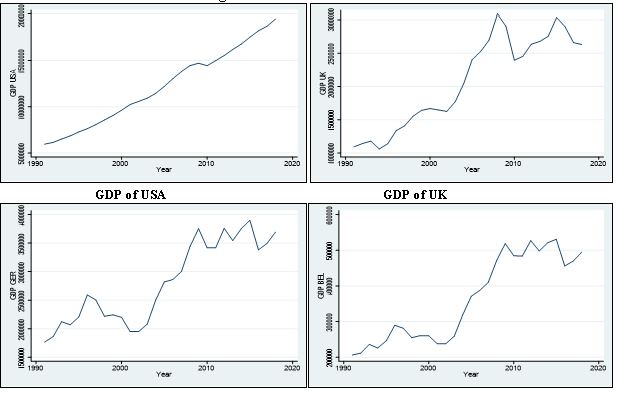Determinants of Jute Export Demand: An Empirical Investigation on Bangladesh
Abstract
This paper investigates the export demand of jute and jute goods of Bangladesh. Following trade literature, a conventional export demand equation is specified for jute export demand of Bangladesh. GDP of trade partner country and Export Unit Value Index[1] (EVI) of Bangladesh are considered as income and price variables respectively. For estimating purposes we only considered five top countries, USA, UK, Belgium, Germany and Australia, where Bangladesh exports more. The regression result shows that income of USA and Australia are only significant determinant of Bangladeshi jute exports. Moreover, export price is also not found significant determinant in case of Bangladeshi jute goods export. Policy implication of these findings are Bangladeshi exporters should not rely on to the traditional markets only. Government should come forward and disseminate information to exporters about market, barriers to be faced and advantages in a particular market.
[1] Export unit value index is a price index that measures average value changes in heterogeneous cluster of units
Downloads
References
Alhroob, M., Irbihat, B., Albashabsheh, A., & Javed, S. (2017). Does Corporate Governance Create Volatility in Performance ? International Journal of Informative & Futuristic Research, 4(7), 6859–6866. Retrieved from http://www.ijifr.com/pdfsave/01-04-2017495IJIFR-V4-E7-075.pdf
Akter, R. (2015). Jute goods exports to Australia: An analysis of market potentials for Bangladeshi jute products. International Journal of Management and Business Studies, 5(2), 21-30.http://www.ijmbs.com/Vol5/2/3-Rahima-Akter.pdf
de Vries, J. (2007). Export of jute products from Bangladesh to Europe: Analysis of market potential and development of interventions for GTZ-PROGRESS [Unpublished Master’s Thesis]. University of Twente, The Netherlands. https://essay.utwente.nl/639/1/scriptie_de_Vries.pdf
European Commission. (2008). Attitudes of European citizens towards the environment (Special Eurobarometer 295). Retrieved March 28, 2019, from https://ec.europa.eu/commfrontoffice/publicopinion/archives/ebs/ebs_295_en.pdf
EPB (2019). Pocket export statistics 2018-2019 (Export Statistics Book) Export Promotion Bureau, Ministry of Commerce, Bangladesh. Retrieved September 28, 2019, fromhttp://epb.portal.gov.bd/site/files/e51e6097-cdb6-424a-9230-91ace9956929
FAOa (n.d.). Faostat (Online Data). Food and Agricultural Organization of the United Nations. Retrieved July 7, 2019, from http://www.fao.org/faostat/en/#data/QC
FAOb (n.d.). Macro indicators (Online Data) Food and Agricultural Organization of the United Nations. Retrieved July 10, 2019, from http://www.fao.org/faostat/en/#data/MK
Goldstein, M. & Khan, M. (1982). Effects of slowdown in industrial countries on growth in non-oil developing countries (Occasional Paper No. 12). International Monetary Fund. Retrieved September 9, 2019, from https://www.elibrary.imf.org/doc/IMF084/02002-9781557750624/02002-9781557750624/Other_formats/Source_PDF/02002-9781455252619.pdf
Gupta, D., Sahu, P. K., & Banerjee, R. (2009). Forecasting jute production in major contributing countries in the world. Journal of Natural Fibers, 6(2), 127-137. https://doi.org/10.1080/15440470902931436
Gujarati, D. N., Porter, D. C., and Gunasekar, S. (2012). Basic econometrics (5th ed.). McGraw-Hill.
Ghosh, B. K. & Jethi, A. (2013). Growth and instability in world jute production: A disaggregated analysis. International Journal of Electronics and Communication Technology, 4(Spl. - 1), 191-195. http://www.iject.org/vol4/spl1/c0061.pdf
Hossain, M. M. & Abdulla, F. (2015). Jute production in Bangladesh: A time series analysis. Journal of Mathematics and Statistics, 11(3), 93-98. https://doi.org/10.3844/jmssp.2015.93.98
Husain, U., & Javed, S. (2019a). Impact of Climate Change on Agriculture and Indian Economy : A Quantitative Research Perspective from 1980 to 2016. Industrial Engineering & Management, 8(2), 2–5. Retrieved from https://www.hilarispublisher.com/open-access/impact-of-climate-change-on-agriculture-and-indian-economy-a-quantitative-research-perspective-from-1980-to-2016.pdf
Husain, U., & Javed, S. (2019b). Stock Price Movement And Volatility In Muscat Security Market ( MSM ). International Journal of Research - Granthaalayah, 7(February), 68–84. https://doi.org/10.5281/zenodo.2580535
Islam, M. S. & Alauddin, M. (2012). World production of jute: A comparative analysis of Bangladesh. International Journal of Management and Business Studies, 2(1), 014-022. https://www.internationalscholarsjournals.com/articles/world-production-of-jute-a-comparative-analysis-of-bangladesh.pdf
Islam, M. M. & Ali, M. S. (2018). Industrial research advances of jute in Bangladesh. International Journal of Agricultural and Biosystems Engineering, 3(1), 1-9. http://article.aascit.org/file/pdf/8050018.pdf
Index Box (2019). World – jute and jute-like fibers – market analysis, forecast, size, trends and insights. Report published by IndexBox, CA: USA. https://www.indexbox.io/store/world-jute-and-jute-like-fibers-market-analysis-forecast-size-trends-and-insights/
Javed, S. (2018). Does Organisation Behaviour Affect Performance Of Auditing Firms? International Journal of Engineering Technologies and Management Research, 5(1), 90–98. https://doi.org/10.5281/zenodo.1171842
Javed, S., Atallah, B., Aldalaien, E., & Husain, U. (2019). Performance of Venture Capital Firms in UK : Quantitative Research Approach of 20 UK Venture Capitals. Middle-East Journal of Scientific Research, 27(5), 432–438. https://doi.org/10.5829/idosi.mejsr.2019.432.438
Javed, S., & Azhar, A. (2017). Forecasting Employee Turnover for Human Resource Based on Time Series Analysis. International Journal Of Economics Research, 14(16), 445–456. Retrieved from https://serialsjournals.com/abstract/46037_ch_37_f_-_forecasting.pdf
Javed, S., Husain, U., & Ali, S. (2020). Relevancy of Investment Decisions And Consumption With Asset Pricing : GMM And CCAPM Model Approach. International Journal of Management, 11(8), 10–17. https://doi.org/10.34218/IJM.11.8.2020.002
Javed, S., & Khan, A. A. (2017). Analysing Parsimonious Model of OL and OE Using SEM Technique. International Journal of Applied Business and Economic Research, 15(22), 685–712. Retrieved from https://serialsjournals.com/abstract/53799_sarfarz_and_azeem.pdf
Khan, A. A., & Javed, S. (2017). A study of volatility behaviour of S & P BSE BANKEX return in India : A pragmatic approach using GARCH model. International Journal of Advanced and Applied Sciences, 4(4), 127–132. https://doi.org/https://doi.org/10.21833/ijaas.2017.04.018
Kabir, M. R. (1988). Estimating imports-demand and export-demand functions: The case of Bangladesh. Bangladesh Development Studies, 16(4), 115-127.https://www.jstor.org/stable/40795339
Malik, A., Khan, N., Faisal, S., Javed, S., & Faridi, M. rashad. (2020). An Investigation On Leadership Styles For The Business Productivity And Sustainability Of Small Medium Enterprises (SME’S). International Journal of Entrepreneurship, 24(5), 1–10. Retrieved from https://www.abacademies.org/articles/an-investigation-on-leadership-styles-for-the-business-productivity-and-sustainability-of-small-medium-enterprises-smes-9845.html
Mujeri, M. K. (1978). The world market for jute: An econometric analysis [Unpublished PhD Thesis]. McMaster University. https://macsphere.mcmaster.ca/bitstream/11375/15723/1/Mujeri%20Mustafa%20Kamal%201.pdf
Molla, M. M. U., Sabu, S. A. & Begum, I. A. (2015). Financial and economic profitability of jute in Bangladesh: A comparative assessment. The Journal of Agriculture and Natural Resource Science, 2(1), 295-303. http://www.journals.wsrpublishing.com/index.php/tjanrs/article/download/175/425
Narayan, S. & Narayan, P. K. (2004). Determinants of demand for Fiji’s exports: An empirical investigation. The Developing Economies, 42(1), 95-112. https://www.ide.go.jp/library/English/Publish/Periodicals/De/pdf/04_01_04.pdf
Rahman, M. & Khaled, N. (2011) Global market opportunities in export of jute (Occasional Paper No. 93), Centre for Policy Dialogue (CPD), Bangladesh. https://www.cpd.org.bd/pub_attach/op93.pdf
Rahman, S., Kazal, M. M. H., Begum, I. A., & Alam, M. J. (2017). Exploring the future potential of jute in Bangladesh. Agriculture, 7(12). 96-112. https://www.mdpi.com/2077-0472/7/12/96
Rutskiy, V., Javed, S., Azizam, S. H., Chudopal, N., Zhigalov, K., Kuzmich, R., & Pupkov, A. (2020). The Price Determinants of Bitcoin as a New Digital Form of Money. (R. Silhavy, P. Silhavy, & Z. Prokopova, Eds.). Springer International Publishing. https://doi.org/10.1007/978-3-030-63322-6
Serrano, R., & Pinilla, V. (2010). Causes of world trade growth in agricultural and food products, 1951–2000: A demand function approach. Applied Economics, 42(27), 3503-3518. https://doi.org/10.1080/00036840802167368
Uddin, M. J., Hossain, J. & Hoque, M. A. (2014). Present condition of jute sector in Bangladesh. Banglavision, 14(1), 68-79. http://bv-f.org/VOL-14/08.%20BV%20Final.pdf
UNCTAD (n.d.). Unit value index of Bangladesh. Retrieved September 23, 2019, from https://unctadstat.unctad.org/wds/TableViewer/tableView.aspx?ReportId=184185

Copyright (c) 2021 INTERNATIONAL JOURNAL OF ECONOMICS, BUSINESS AND HUMAN BEHAVIOUR

This work is licensed under a Creative Commons Attribution-NonCommercial 4.0 International License.











